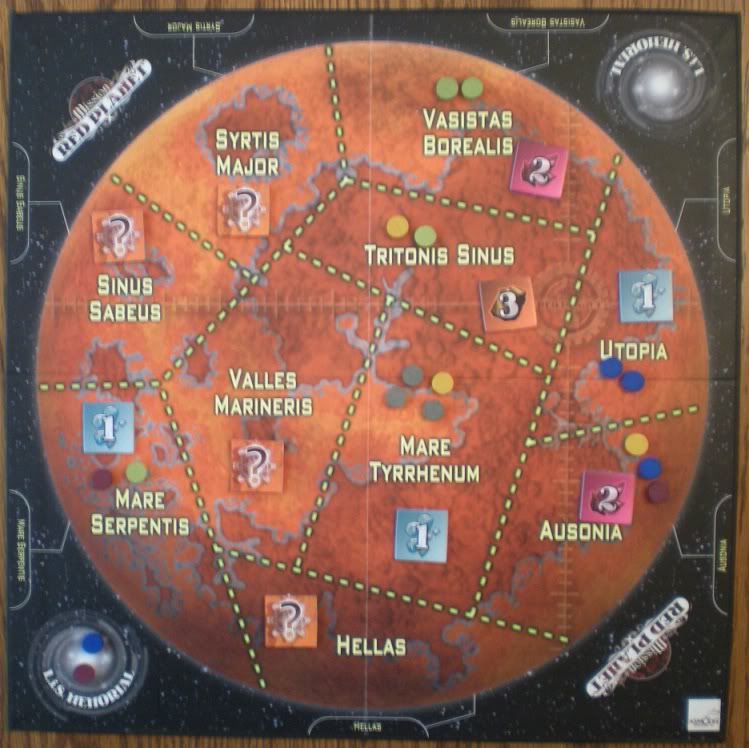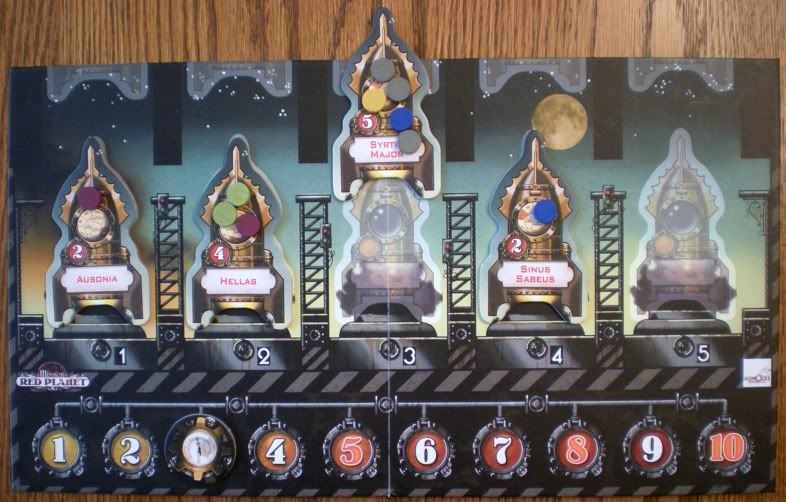3-5 players / 10+ / 60 minutes
Inside, I was smiling proudly. Just the previous turn, I had successfully put three astronauts on a rocket, which left only one space that didn't do the others much good. Now I was ready to place a fourth and gloriously claim a region of Mars for...um...well, the color Green! That is, if they made it there alive! Brendon is always the one who likes to blow things up, but he already played his Saboteur. I waited thoughtfully as roles were called out in order. Surely none of the others would dare? Why, they are always so peaceful. Brendon is my only pyro. Then, nervously, I called out for role #5, the Saboteur. All quiet. Would I succeed? And then...a grin...from Hope. Hope! Oh, how ironic a girl with such a name would ruin mine! She flips it over and gestures to my rocket. You little twerp!
What You Get:
The components are not particularly impressive, but they are certainly functional. The two boards are small (not a criticism) and refuse to lay flat (a criticism). The "astronauts" are tiny wooden discs, smaller than a smartie, and difficult for my fat nubs to handle. The rockets, destination markers, and scoring tokens are all on a sturdy enough cardboard - but be careful punching them out as they are not perforated well. The cards are slick and of basic stock. While I could take some flak for commenting on a vac tray, the one here is about worthless and was not designed for this game. I just tossed mine and, as a result, all the (bagged) pieces just kind of shift around inside. The artwork, however, is the exception to the average components. Produced in a steampunk style, the role cards and rocket ships are fantastically imaginative and evocative of an H. G. Wells world.
The Quick Rundown:
 |
| Mars! With astronauts. |
Rated E for Everyone:
 | |
| The launch pad. |
First of all, gameplay is smooth and easy. It is not heavy on rules. At the beginning of each round, you'll secretly select which character you want and take your turn as each is revealed in order. Each person has the same set of role cards, so it's possible you'll select the same role as another player in any given round. Regardless, the character cards clearly define what actions you make take, how to perform them, and where. The two in-game scoring rounds are a also very simple matter. The only bit of confusion comes in scoring at the end of the game, since the Discovery and Bonus cards can change up how points are awarded.
Gameplay is also fast! The game consists of exactly 10 rounds, with scores tabulated after rounds 5, 8, and 10. This limit keeps the game consistently at 60 minutes or less. It also adds a good deal of excitement and tension since you never seem to have quite enough time to do everything you want. Individual turns are also brief. Essentially you place astronauts on a ship and then perform your character's special ability. Then it's the next person's turn. This keeps downtime to a wonderful minimum.
The theme is fun and on the lighter side. The characters generally work and their abilities make sense. Not that I'm asking for realism in a game about steam power launching rockets to Mars in the Victorian Era. Still, I'm not sure how the Femme Fatale makes sense in the scheme, nor what the ability to switch astronauts has to do with the archetype. She could have been a ninja, robber baron, or voodoo witch doctor, for all that. In any event, the unique and creative theme makes for an enjoyable hour of gameplay and helps sooth the burns of conflict.
The spite aspect I think will really make this title a "take it or leave it" extreme. You'll either take it in stride with the understanding that its a central mechanic of this game's design. Or you'll leave it because it'll cause too many fights and heartaches. However, the spite is mitigated somewhat through the limitations of role selection. Once you play a character, you cannot play that role again in future turns until you spend one turn playing the Recruiter. He allows you to collect all previously used characters so that they are available again in subsequent rounds. Therefore, you're not able to kill off opposing astronauts turn after turn after turn, ad nauseum. Also, the non-spiteful roles provide other abilities that are too beneficial to ignore. You simply can not spend the entire game going after the other players. In a two-player game you might win with that strategy, but I imagine that is the main reason this is a game for 3-5 players.
 |
| The cast of characters. |
Now while the interaction isn't necessarily incessant, I don't mean to minimize it's impact. When you are attacked, it can really be rough and derail your plans. Since you have so few turns to implement any strategy, one well-timed attack can really cause irreparable damage. Also, Discovery cards can be played secretly in certain regions which change the way they are scored at the end of the game. So even if you have the majority in the region, it may not matter. The Scientist role does let you sneak a peek at a card so you can avoid or prepare for any surprises; but if a lot of them are put into play, the percentages start mounting against you. And then there are Bonus cards. Some assign you a secret mission to accomplish by the end of the game for extra points. There is some strategy in completing these missions, as long as another player doesn't derail them! Then others just randomly give you extra points without any effort exerted on your part. The balance here is that these factors affect all players equally. But that may provide little consolation to heavy strategy gamers who like to have most of the control and information at all times.
Okay, I'll Shut Up Now:
In the end, I give Mission: Red Planet an 8 on the Geek scale (Very good game. I like to play. Probably I'll suggest it and will never turn down a game.). Despite the abruptness of the interaction, I would recommend this title as a sort of "gateway" game to introduce your kids to conflict and spite. There are many hobby games, even typically peaceful Euros, that utilize some sort of "take that" mechanic in which you can attack your opponents, or otherwise mess with their plans. The sooner they learn to deal with it as a good sport, the better. This smooth, brisk, and creatively themed title provides a quick gameplay experience that just might serve well in easing them into that transition.

Thanks for the review. This is one I'm interested in. I heard it's similar to Citadels. How does it compare to that game?
ReplyDelete(A bit of backstory on Citadels: I loved the game, but the medieval/fantasyish artwork turned off my non-geek friends, so I never really got to play it much. This looks like an interesting enough retheme to attract those non-geeks. Any thoughts on this front would also be accepted and appreciated. :-) )
Yes, the comparison is common, and partly valid because of the secret role selection mechanic in both titles. But instead of drafting the same deck of characters in Citadels, each player has their own set of character cards in Mission: Red Planet. The psychological meta game of who’s who in Citadels is still present in M:RP, but it’s not as stressful since another player can’t take the character that you were really hoping for.
ReplyDeleteThe chaos is also more pronounced in M:RP because of that. We’ve had turns where everyone played an attacking character and so the result of astronauts dying off left and right was humorously crazy. You also have less control over scoring in M:RP because of the Discovery and Bonus cards. Info on your progress is more readily at hand in Citadels.
Where the games do feel interestingly similar is in the fact that the role selection mechanic drives the game and the other mechanics are dependent upon that. In Citadels, the tableau building only feels like a means to provide resolution for the character drafting. If you like other tableau building games like Race for the Galaxy or Innovation, I’m not sure that means you’ll automatically like Citadels. And the same with M:RP – just because you like area majority games like El Grande or China, don’t automatically assume you’ll enjoy this take on the genre, because the role selection is the heart of the game and really drives the area majority mechanic, not the other way around.
As for your friends’ issue with the theme of Citadels, M:RP might solve that. Its theme is creative and integrated well into the game; as opposed to the medieval city building that’s really just pasted onto Citadels.
Wow! Thanks for the comprehensive reply. This gives me a better idea about the game. It seems like it would have a welcome place in my collection, since the role selection is what I like best about Citadels. The only thing I see that could be an issue for me is multiple people choosing the same role at the same time. I'll have to find a copy sometime to give it a try.
ReplyDeleteAgain, thanks for your thoughts.